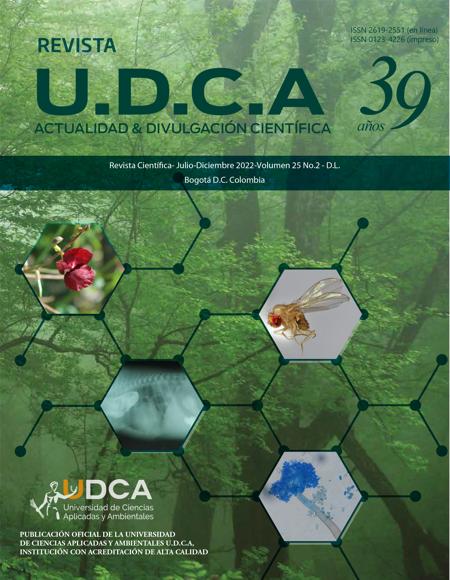Influencia de consorcios microbianos en la incidencia del moho gris (Botrytis cinerea) en fresa (variedad Monterey)
Influence of microbial consortia on the incidence of grey mold (Botrytis cinerea) in strawberry (Monterey variety)
Contenido principal del artículo
Resumen
Botrytis cinerea, el agente causal de la enfermedad del moho gris, es uno de los patógenos más destructivos del cultivo de fresa, tanto en el desarrollo vegetativo como en poscosecha. El control de este patógeno es complejo, debido a su agresividad y capacidad de atacar e infectar diversos tejidos de la planta y se basa, principalmente, en el control químico; sin embargo, el uso incorrecto de plaguicidas, principalmente por sobredosificación, provoca la presencia de trazas de estos agroquímicos en los frutos, así como la selección de resistencia del patógeno a los fungicidas, convirtiéndolo en un riesgo para la salud humana y el ambiente. El objetivo del estudio fue utilizar estrategias de regulación biológica, con la aplicación de consorcios microbianos, conformados por hongos micorrícicos, bacterias antagonistas y Trichoderma harzianum, como alternativa para el manejo del moho gris, en cultivos de fresa (variedad Monterey), en condiciones de campo. Los tratamientos T4 (hongos micorrízicos), T8 (hongos micorrízicos, bacterias antagonistas y T. harzianum) y T2 (T. harzianum) presentaron la menor incidencia del patógeno, con 2,6, 3,1 y 3,6 %, respectivamente, en comparación con las plantas control, con 16,6 %. La influencia de todos los tratamientos biológicos en la regulación de B. cinerea fue mayor respecto al control.
Palabras clave:
Descargas
Datos de publicación
Perfil evaluadores/as N/D
Declaraciones de autoría
- Sociedad académica
- Universidad de Ciencias Aplicadas UDCA
- Editorial
- Universidad de Ciencias Aplicadas y Ambientales U.D.C.A
Detalles del artículo
Referencias (VER)
AVIS, T.J.; GRAVEL, V.; ANTOUN, H.; TWEDDELL, R.J. 2008. Multifaceted beneficial effects of rhizosphere microorganisms on plant health and productivity. Soil Biology and Biochemistry. 40(7):1733-1740.
https://doi.org/10.1016/j.soilbio.2008.02.013
BISUTTI, I.L.; PELZ, J.; BÜTTNER, C.; STEPHAN, D. 2017. Field assessment on the influence of RhizoVital® 42 fl. and Trichostar® on strawberries in the presence of soil-borne diseases. Crop Protection. 96:195-203.
https://doi.org/10.1016/j.cropro.2017.02.004
BRIMNER, T.A.; BOLAND, G.J. 2003. A review of the non-target effects of fungi used to biologically control plant diseases. Agriculture, Ecosystems & Environment. 100(1):3-16.
https://doi.org/10.1016/S0167-8809(03)00200-7
CANO, M.A. 2011. Interacción de microorganismos benéficos en plantas: Micorrizas, Trichoderma spp. y Pseudomonas spp. una revisión. Revista U.D.C.A Actualidad & Divulgación Científica. 14(2):15-31.
https://doi.org/10.31910/rudca.v14.n2.2011.771
CAO, S.; HU, Z.; ZHENG, Y.; YANG, Z.; LU, B. 2011. Effect of BTH on antioxidant enzymes, radical-scavenging activity and decay in strawberry fruit. Food Chemistry. 125(1):145-149.
https://doi.org/10.1016/j.foodchem.2010.08.051
CHALFOUN, N.R.; CASTAGNARO, A.P.; DÍAZ RICCI, J.C. 2011. Induced resistance activated by a culture filtrate derived from an avirulent pathogen as a mechanism of biological control of anthracnose in strawberry. Biological Control. 58(3):319-329.
https://doi.org/10.1016/j.biocontrol.2011.05.007
COTES, A.M. 2014. Control biológico de enfermedades de plantas en Colombia. En: Bettiol, W.; Rivera, M.C.; Mondino, P.; Montealegre, J.R.; Colmenárez, Y.C. (eds). Control bilógico de enfermedades de plantas en América Latina y el Caribe. Universidad de la República. p.169-179.
FILLINGER, S.; LEROUX, P.; AUCLAIR, C.; BARREAU, C.; AL HAJJ, C.; DEBIEU, D. 2008. Genetic analysis of Fenhexamid-Resistant field isolates of the phytopathogenic fungus Botrytis cinerea. Antimicrobial agents and chemotherapy. 52(11):3933-3940.
https://doi.org/10.1128/aac.00615-08
FINLAY, R.D. 2004. Mycorrhizal fungi and their multifunctional roles. Mycologist. 18(2):91-96.
https://doi.org/10.1017/S0269-915X(04)00205-8
FREEMAN, S.; KATAN, T. 1997. Identification of Colletotrichum species responsible for anthracnose and root necrosis of strawberry in Israel. Phytopathology. 87(5):516-521.
https://doi.org/10.1094/phyto.1997.87.5.516
FUNGICIDE RESISTANCE ACTION COMMITTEE, FRAC. 2013. List of plant pathogenic organisms resistant to disease control agents. FRAC. 71p. Disponible desde Internet en:
GUÉDEZ, C.; CAÑIZÁLEZ, L.; CASTILLO, C.; OLIVAR, R. 2009. Efecto antagónico de Trichoderma harzianum sobre algunos hongos patógenos postcosecha de la fresa (Fragaria spp.). Revista de la Sociedad Venezolana de Microbiología. 29(1):34-38.
HARMAN, G.E. 2006. Overview of mechanisms and uses of Trichoderma spp. Phytopathology. 96(2):190-194.
https://doi.org/10.1094/phyto-96-0190
HARMAN, G.E.; PETZOLDT, R.; COMIS, A.; CHEN, J. 2004. Interactions Between Trichoderma harzianum strain T22 and maize inbred line Mo17 and effects of these interactions on diseases caused by Pythium ultimum and Colletotrichum graminicola. Phytopathology. 94(2):147-153.
https://doi.org/10.1094/phyto.2004.94.2.147
HAUSE, B.; MROSK, C.; ISAYENKOV, S.; STRACK, D. 2007. Jasmonates in arbuscular mycorrhizal interactions. Phytochemistry. 68(1):101-110.
https://doi.org/10.1016/j.phytochem.2006.09.025
HAUSE, B.; SCHAARSCHMIDT, S. 2009. The role of jasmonates in mutualistic symbioses between plants and soil-born microorganisms. Phytochemistry. 70(13-14):1589-1599.
https://doi.org/10.1016/j.phytochem.2009.07.003
KAPOOR, R.; SHARMA, D.; BHATNAGAR, A.K. 2008. Arbuscular mycorrhizae in micropropagation systems and their potential applications. Scientia Horticulturae. 116(3):227-239.
https://doi.org/10.1016/j.scienta.2008.02.002
LANTZ, W.; SWARTZ, H.; DEMCHAK, K.; FRICK, S. 2010. Season-long strawberry production with ever bearers for northeastern producers. University of Maryland Extension. 70p.
LEROUX, P.; GREDT, M.; LEROCH, M.; WALKER, A.-S. 2010. Exploring mechanisms of resistance to respiratory inhibitors in field strains of Botrytis cinerea, the causal agent of gray mold. Applied and Environmental Microbiology. 76(19):6615-6630.
https://doi.org/10.1128/aem.00931-10
LI, R.; TAO, R.; LING, N.; CHU, G. 2017. Chemical, organic and bio-fertilizer management practices effect on soil physicochemical property and antagonistic bacteria abundance of a cotton field: Implications for soil biological quality. Soil and Tillage Research. 167:30-38.
https://doi.org/10.1016/j.still.2016.11.001
LI, X.; XIE, X.; XING, F.; XU, L.; ZHANG, J.; WANG, Z. 2019. Glucose oxidase as a control agent against the fungal pathogen Botrytis cinerea in postharvest strawberry. Food Control. 105:277-284.
https://doi.org/10.1016/j.foodcont.2019.05.037
MERCHÁN-GAITÁN, J.B.; FERRUCHO, R.L.; ÁLVAREZ-HERRERA, J.G. 2014. Efecto de dos cepas de Trichoderma en el control de Botrytis cinerea y la calidad del fruto en fresa (Fragaria sp.). Revista Colombiana de Ciencias Hortícolas. 8(1):44-56.
MINISTERIO DE AGRICULTURA, MINAGRICULTURA. 2021. Cadena de la fresa. Minagricultura. 22p. Disponible desde Internet en:
https://sioc.minagricultura.gov.co/Fresa/Documentos/2021-03-31%20Cifras%20Sectoriales.pdf
MONDAL, T.; DATTA, J.K.; MONDAL, N.K. 2017. Chemical fertilizer in conjunction with biofertilizer and vermicompost induced changes in morpho-physiological and bio-chemical traits of mustard crop. Journal of the Saudi Society of Agricultural Sciences. 16(2):135-144.
https://doi.org/10.1016/j.jssas.2015.05.001
PERTOT, I.; GIOVANNINI, O.; BENANCHI, M.; CAFFI, T.; ROSSI, V.; MUGNAI, L. 2017. Combining biocontrol agents with different mechanisms of action in a strategy to control Botrytis cinerea on grapevine. Crop Protection. 97:85-93.
https://doi.org/10.1016/j.cropro.2017.01.010
PERTOT, I.; ZASSO, R.; AMSALEM, L.; BALDESSARI, M.; ANGELI, G.; ELAD, Y. 2008. Integrating biocontrol agents in strawberry powdery mildew control strategies in high tunnel growing systems. Crop Protection. 27(3-5):622-631.
https://doi.org/10.1016/j.cropro.2007.09.004
POZO, M.J.; AZCÓN-AGUILAR, C. 2007. Unraveling mycorrhiza-induced resistance. Current Opinion in Plant Biology. 10(4):393-398.
https://doi.org/10.1016/j.pbi.2007.05.004
PRITTS, M. 2002. Growing strawberries, healthy communities, strong economies and clean environments: what is the role of the researcher? Acta Horticulturae. 567:411-417.
https://doi.org/10.17660/ActaHortic.2002.567.85
PROGRAMA DE TRANSFORMACIÓN PRODUCTIVA, PTP.; ASOCIACIÓN HORTIFRUTICOLA DE COLOMBIA, ASOHOFRUCOL.; FONDO NACIONAL DE FOMENTO HORTIFRUTÍCOLA. 2013. Plan de negocios de fresa: Programa de transformación productiva. 171p.
SELOSSE, M.-A.; BAUDOIN, E.; VANDENKOORNHUYSE, P. 2004. Symbiotic microorganisms, a key for ecological success and protection of plants. Comptes Rendus Biologies. 327(7):639-648.
https://doi.org/10.1016/j.crvi.2003.12.008
STOKES, M.E.; DAVIS, C.S.; KOCH, G.G. 2012. Categorical Data Analysis Using SAS. Third Edition. SAS Institute Inc (Cary, NC). 590p.
VÁZQUEZ, M.M.; CÉSAR, S.; AZCÓN, R.; BAREA, J.M. 2000. Interactions between arbuscular mycorrhizal fungi and other microbial inoculants (Azospirillum, Pseudomonas, Trichoderma) and their effects on microbial population and enzyme activities in the rhizosphere of maize plants. Applied Soil Ecology. 15(3):261-272.
https://doi.org/10.1016/S0929-1393(00)00075-5
VESTBERG, M.; KUKKONEN, S.; SAARI, K.; PARIKKA, P.; HUTTUNEN, J.; TAINIO, L.; DEVOS, N.; WEEKERS, F.; KEVERS, C.; THONART, P.; LEMOINE, M.-C.; CORDIER, C.; ALABOUVETTE, C.; GIANINAZZI, S. 2004. Microbial inoculation for improving the growth and health of micropropagated strawberry. Applied Soil Ecology. 27(3):243-258.
https://doi.org/10.1016/j.apsoil.2004.05.006
WEHNER, J.; ANTUNES, P.M.; POWELL, J.R.; MAZUKATOW, J.; RILLIG, M.C. 2010. Plant pathogen protection by arbuscular mycorrhizas: A role for fungal diversity? Pedobiologia. 53(3):197-201.
https://doi.org/10.1016/j.pedobi.2009.10.002
YANG, H.-H.; YANG, S.L.; PENG, K.-C.; LO, C.-T.; LIU, S.-Y. 2009. Induced proteome of Trichoderma harzianum by Botrytis cinerea. Mycological Research. 113(9):924-932.
https://doi.org/10.1016/j.mycres.2009.04.004
ZHANG, H.; WANG, L.; DONG, Y.; JIANG, S.; CAO, J.; MENG, R. 2007. Postharvest biological control of gray mold decay of strawberry with Rhodotorula glutinis. Biological Control. 40(2):287-292.







